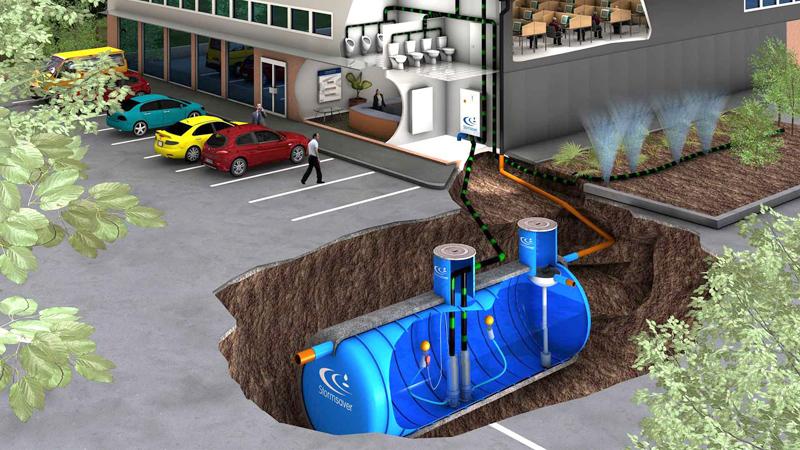
Reference the news item on rainwater harvesting project in Jaffna (Sunday Observer, Sept. 24) I write following a recent visit to Western Australia.
The article stated that “A project to save and reuse rainwater in Jaffna Peninsula as a solution to the prevailing drought”. This project has been initiated with the approval of the Cabinet and the Chief Minister of the Northern Province under the guidance of the policy development office of the Prime Minister.
Similar to this project, the Government of Western Australia already engages in save and reuse rainwater from roof of houses. Rainwater from our roof can be a valuable resource as it can contribute to our yearly water needs and help conserve drinking water reserves. However, a reticulated scheme of drinking water supply remains the most reliable source of drinking water in the urban environment in Western Australia.
The Department of Health in Western Australia supports the use of rainwater tanks in urban areas for all non-potable uses, such as garden watering, flushing toilets, washing machines and car washing. Using rainwater in this way will not pose a risk to our health.
If we live in an urban area and would like to drink rainwater, we should be aware that there might be an increased risk of pollution by airborne chemical and micro-biological contamination. Also, poorly maintained rainwater tanks can breed mosquitoes that can carry human disease to us and our neighbours. Therefore, the Government of Australia has taken steps to minimize the risk of contamination if they intend to drink rainwater.
Is rainwater always safe to drink?
Unless adequately treated, rainwater is not reliably safe to drink. It is almost impossible to completely protect rainwater from: bird droppings and other debris containing microorganisms, air pollution caused by light industries such as spray painters and fiberglass fabricators, heavy industries such as kilns, quarries, chemical plants and emission from motor cars associated with freeways and main roads.
(The level of contamination in your rainwater will depend upon the amount of debris collected in your gutters and on your roof also your proximity to heavy traffic, incinerators, light or heavy industry).
What is on the roof?
Rainwater can be collected from most types of roofs, including asbestos, colourbond and galvanized. It is important to find out if your roofing material or the paint used on the roof or in gutters etc. could contaminate rainwater. For example, tar based coatings can bind other harmful organic chemicals to the roof or gutter and be difficult to clean.
The government of Australia has made arrangement with the families, for them to speak to their rainwater tank supplier about identifying materials on the roof that could contaminate their rainwater.
How do I maintain my Rainwater system?
Regular maintenance is the key to good water quality, installing screens, filters and first flush devices will reduce contamination. Likely sources by microorganisms and chemical contaminants that they can control are: overhanging branches, soil and leaf litter accumulated in gutters, particularly if kept damp for long periods due to poor drainage, faecal matter deposited by birds (resting on wires and T.V. Antennas) lizards, mice, rats etc., and dead animals and insects either in gutters or in the tank itself. Therefore, it is important that roofs, gutters screens and first flush devices be inspected and cleared of leaves and other debris, every three to four months.
The first flush runoff from a roof will wash contaminants such as dust, bird droppings, leaves and other airborne contaminants into your tank. First flush devices prevent the first portion of roof from entering the tank.
Are mosquitoes a problem?
Rainwater tanks can become breeding sites for mosquitoes that can cause a severe nuisance and carry serious diseases. In Western Australia the most common mosquito found to breed in poorly maintained rainwater tanks is a proven carrier of Ross River Virus. Therefore, it is compulsory to prevent mosquito breeding. Corrosion and metal contamination, guttering and pipework should be self-draining or fitted with drainage points, water should not be allowed to remain under the overflow outlet or tap as these can become mosquito breeding sites. The tank should be a sealed unit with the lid preventing sunlight from reaching the water. Sunlight encourages the growth of algae that will taint the water. Holes and spaces will allow mosquitoes to enter. The inlet should incorporate a mesh cover and a strainer to keep leaves and prevent the access of mosquitoes and other insects. The overflow should also be covered with an insect poof cover such as, plastic insect mesh wired around the pipe.
Arrangement made to stop mosquito breeding: add a teaspoon of food grade paraffin oil (in small tanks up to a thousand litres) to the water. (The amount needed will vary depending on the surface area of the water. A sufficient quantity to produce a thin film over the water surface is all that is required.)
If rainwater is to be drunk or used in cooking for any reason, it should first be disinfected either by bringing to a rolling boil for a few seconds, or by chlorination. Rainwater tanks connected to the scheme must be fitted with an approved backflow prevention device installed by a licensed plumber. Before purchasing and installing a rainwater tank it is a primary duty to check with your local government for local building regulations that apply in your area. As some PVC pipes may contain lead, if the water is for drinking purposes use only high grade “food” plastic pipes and fittings...
Source: Environmental Health Directorate Department of Health, Govt. of Western Australia.
